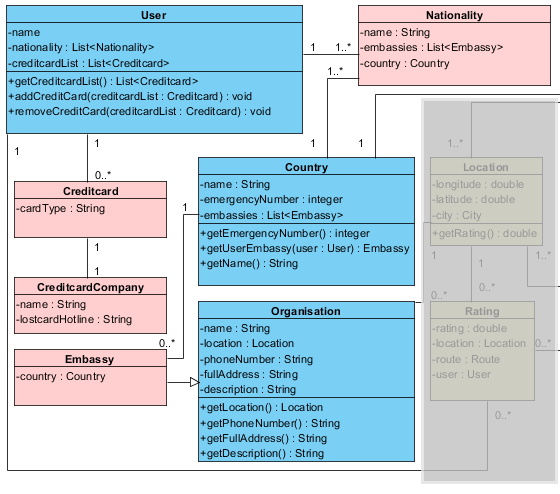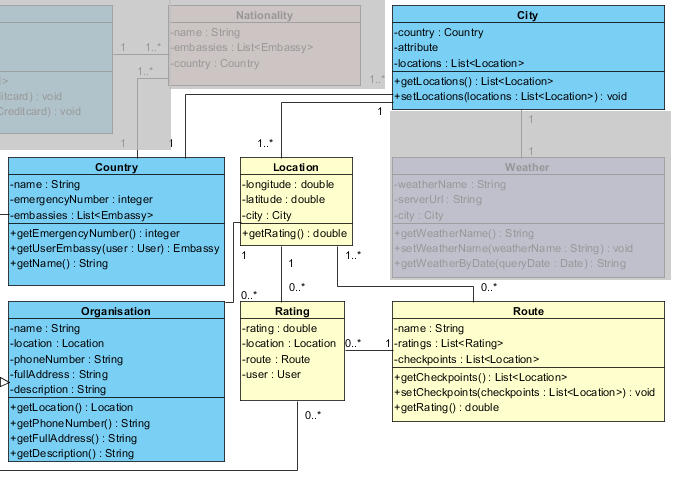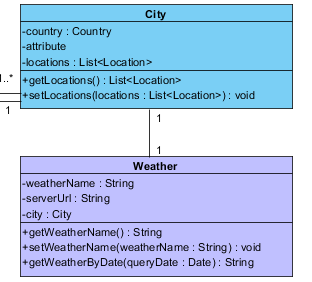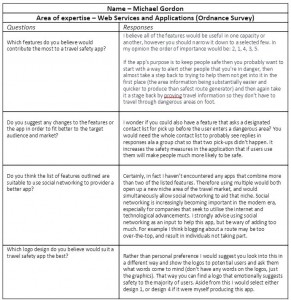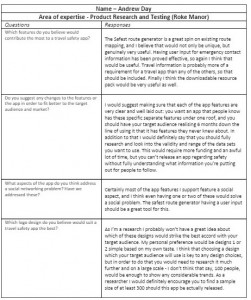Posts Tagged Engineering Considerations
Structural Design of the App – Class Diagram
Posted by Po Ting Tse in Design, Engineering, Media Use on 14/04/2015
Based on the proposed use case diagram, the group would like to present the structural design of the application. Figure 1 is the class diagram consists of 12 classes including User, Nationality, Creditcard, CreditcardCompany, Organisation, Embassy, Country, City, Location, Rating, Route, Weather.
Figure 1 The class diagram of the application
The class diagram is divided into three parts:
1) Emergency (Figure 2): The classes store essential information, including the contact of embassy and Credit Card Company. The classes related are User, Nationality, Creditcard, CreditcardCompany, Organisation, Embassy.
Class User records the user details and operations and the classes contains essential information, including the contact of embassy and Credit Card Company. Users can store their basic card details in the application, and it links to corresponding cardlost hotlines when there is emergency. The application does not store any personal details (eg. credit card number) to reduce the privacy risks.
Figure 2 the classes related to emergency situations
2) Generate safety Routes (Figure 3): Class Country contains a list of City class. Each route stores a sequence of locations as checkpoints of the route. Users can rate a route, a location after they finish the route.
Figure 3 the classes related to generate safety routes
3) Weather integration (Figure 4): the weather information is considered while generating every safety routes. The Weather Class contains functions for retrieving specific weather information.
Figure 4 the classes related to weather
Written by Po Ting Tse
This post represents that the group has chosen appropriate economic and social Contextual Factors that directly link to the marking criteria, and are vital to understanding what requirements app design has. This is based on market analysis, evaluation, and previous engineering decisions. There is evidence that research has been chosen intelligently (by reference to literature and analysis) to produce a conclusion of professional quality, leading to a successful product.
This post additionally represents Engineering and Design decisions. These are based on the Contextual Factors and literature review which the group have tailored the product to incorporate. This means that the activity diagram has considerable research, fluent design and well planned engineering steps to achieve this. This post illustrates how and why the product has been influenced in its design and engineering, and shows how the engineering of the app will solve problems through multiple class diagrams.
In addition, this post illustrates considerable use of media, innovation and creativity. This is apparent through applying Contextual Research, Design steps and engineering guidelines to produce class diagrams which contribute to the product, summarises what the product does, and provides visualisations that align with the target market.
Furthermore this post features the use of different types of media evident in the class diagrams.
Expert Opinions and Advice for App Features
Posted by Briony Gray in Contextual Factors and Research, Engineering on 16/03/2015
With a global increase in the use of smartphones and tablets, there is an ever growing market for Applications (apps) and other specifically tailored features for these devices (Shin et al., 2012). Over the years these have evolved and adapted to a market of their own, and many boast specialised features, well-known brands and millions of users (Bellman et al., 2011). With such a vast and thriving scene one must look towards expert advice and opinions in order to identify gaps in the existing market (Lin et al., 2014).
Expert opinions may vary depending on the size and purpose of a company therefore it is import to select suitable individuals fitted for the scale of company and/or app. As our project is a university coursework and we will not release the app to the public, local experts in web design, features and devices will be suitable for guidance on the project. The features that the experts were asked to comment upon was produced by market research, user research, literature and group consensus. This list is as follows:
- 1. Safest Route Generator – This generates three safest routes from point to point in real-time2. Area Information Safety Rating – This is used for areas using open data crime statistics and social media3. Local Travel Information Updates – This provides local bus and train times, locations of these, and weather information Weather updates.
4. Safety Information – This is generated from locational based RSS feeds from embassies, social media and news feeds.
5. Emergency Contact Information – This is done through user input which an individual stores travel information such as flight numbers, travel insurance, credit card numbers, and emergency contact details.
6. Downloadable Resource Pack – This allows the user to choose a location and download above features (such as travel information or safety information) which can be accessed while offline. This combats roaming charges while travelling.
7. Blogging Features – e.g. photo and video with GPS location – Links to social media e.g. photo and video
post uploads, blog posts.
8. Family Alerts – This features a danger button to send location to designated contacts, and/or emergency services or the police.
9. Flight Information – This provides information from airport/airlines with notifications for specified Pack offline.
The designs that the experts were asked to select from has been posted in the ‘App Logo Designs’ blog post, which can be found in the portfolio. The experts were selected through purposive sampling, as the sample was required to be small and to produce in depth qualitative feedback. They were addressed via email as it can be recorded easily and any points further discussed with minimum effort. Each expert has consented to basic personal data (i.e. name and expertise area) to be disclosed in this feedback session, along with a copy of their answers.
In order to read the tables please click on the image to enlarge. Please note that you made need to zoom in to read the text more easily, this is due to a formatting error with wordpress.
Written by Briony and Taekyun.
This post represents that the group has chosen appropriate economic and social Contextual Factors that directly link to the marking criteria, and are vital to understanding what requirements the product will have in terms of useful app features. These are based on market analysis, evaluation of existing products, and identification of useful app features. These have been presented to experts to ensure further guidance and feedback for contextual factors. There is evidence that questions and the short-list of app features have been chosen intelligently (by reference to literature and analysis) to produce a conclusion of professional quality, leading to a successful product.
The feedback from expert opinions and the adaptation of the product based on this represents intelligent engineering choices. This tackles the weaknesses of existing app features and adds further appropriate engineering structure to the product.
References
Bellman, S., Potter, R. F., Treleaven-Hassard, S., Robinson, J. A., & Varan, D. (2011). The effectiveness of branded mobile phone apps. Journal of interactive Marketing, 25(4), 191-200.
Lin, Y. H., Fang, C. H., & Hsu, C. L. (2014). Determining Uses and Gratifications for Mobile Phone Apps. In Future Information Technology (pp. 661-668). Springer Berlin Heidelberg.
Shin, C., Hong, J. H., & Dey, A. K. (2012, September). Understanding and prediction of mobile application usage for smart phones. In Proceedings of the 2012 ACM Conference on Ubiquitous Computing (pp. 173-182). ACM.

